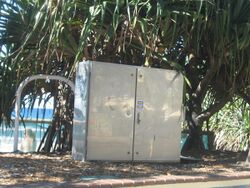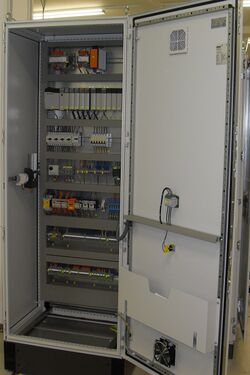Engineering:Electrical enclosure
An electrical enclosure is a cabinet for electrical or electronic equipment to mount switches, knobs and displays and to prevent electrical shock to equipment users and protect the contents from the environment. The enclosure is the only part of the equipment which is seen by users. It may be designed not only for its utilitarian requirements, but also to be pleasing to the eye. Regulations may dictate the features and performance of enclosures for electrical equipment in hazardous areas, such as petrochemical plants or coal mines. Electronic packaging may place many demands on an enclosure for heat dissipation, radio frequency interference and electrostatic discharge protection, as well as functional, esthetic and commercial constraints.
Standards
In the United States, the National Electrical Manufacturers Association (NEMA) publishes NEMA enclosure type standards for the performance of various classes of electrical enclosures. The NEMA standards cover corrosion resistance, ability to protect from rain and submersion, etc.
For IEC member countries, standard IEC 60529 classifies the ingress protection rating (IP Codes) of enclosures.
Materials
Electrical enclosures are usually made from rigid plastics, metals, particularly stainless steel, carbon steel, and aluminum. Steel cabinets may be painted or galvanized. Mass-produced equipment will generally have a customized enclosure, but standardized enclosures are made for custom-built or small production runs of equipment. For non-metallic enclosures; ABS plastic is acceptable for indoor only applications requiring a low NEMA rating (1, or 2), and are not adequate for harsh environments. For NEMA 3 and above polycarbonate, glass-reinforced, polycarbonate, and fiberglass boxes are used and have a gasket to ensure dry and dust free area within the box. Choosing an electrical enclosure that is right for a type of application is essential to avoid failure. [1]
Stainless steel and carbon steel
Carbon Steel and Stainless Steel are both used for enclosure construction due to their high durability and corrosion resistance, these materials are also moisture resistant and chemical resistant. They are the strongest of the construction options, able to withstand the greatest amount of impact while maintaining aesthetics.
Additionally, Stainless Steel electrical enclosures are best suited for medical, pharma, and food industry applications since they are bacterial and fungal resistant due to their non-porous quality.[2]
NEMA Ratings- 3R, 4, 12, 13.
Aluminum enclosures
This material is chosen because of its light weight, relative strength, low cost, and corrosion resistance. It performs well in harsh environments and it is sturdy, capable of withstanding high impact with a high malleable strength. Aluminum also acts as a shield against electromagnetic frequency and radio frequency interference.[3]
NEMA Ratings- 1, 4, 4x, 12, 13
Polycarbonate
Polycarbonate is basically plastic. When used for electrical enclosures its construction is similar to that of the production of bulletproof windows or police shields. It is strong but light, non-conductive and non-magnetic. It is also resistant to corrosion and some acidic environments; however, it is sensitive to abrasive cleaners. When it comes to electrical enclosures, Polycarbonate is the easiest material to modify in case it is needed.[4]
NEMA Ratings- 1, 2, 3, 3R, 3S, 4, 4X, 5, 12, 13, 6P, 12, 13, and Marine Use
Fiberglass
Fiberglass in enclosure construction is conceived to handle chemicals and in corrosive applications. Due the material’s sturdy frame it is capable of handling extreme temperatures, this is why they are used in indoor and outdoor applications making it more flexible in its use than the Polycarbonate enclosures. Additionally, Fiberglass can be installed in environments that are constantly wet.[5]
NEMA Ratings: 1, 2, 3, 3R, 4, 4X, 6P, 12, and 13
Terminology
Enclosures for some purposes have partially punched openings (knockouts) which can be removed to accommodate cables, connectors, or conduits. Where they are small and primarily intended to conceal electrical junctions from sight, or protect them from tampering, they are also known as junction boxes, street cabinets or technically as serving area interface.
Telecommunications
Telcordia Technologies has proposed generic requirements for telecommunication equipment cabinets. These requirements were developed with the input of United States service providers,[6] and are intended to provide a suitable environment for telecommunication companies’ electronic and passive equipment that is housed in above-ground cabinets or enclosures (typically pad- or pole-mounted) in an outside plant environment. The proposed standard includes functional design criteria, generic mechanical and environmental requirements, desired features, and performance tests.
Telecommunication huts are fully assembled or modular field-assembled transportable structures capable of housing an electronic communications system. These huts provide a controlled internal environment for the communications equipment and occasional craftspersons. The huts are designed with locks, security, and alarms to discourage access by unauthorized persons. Huts can be provided with a decorative facade to comply with local building requirements. Telecommunications huts are designed to withstand climate conditions existing throughout the USA including rain, snow, sleet, high winds, ice, sand storms, earthquakes and lightning.
Electronic equipment cabinets can be placed in both indoor and outdoor locations. As described in industry standards GR-3031[7] and GR-3033,[8] the cabinets consist of the outer-finished closure box along with its integral hardware components, such as bonding and grounding connections; internal walls and braces for splicing chambers and battery compartments; frame and shelving tracks; and doors, seals, and hinges.
Battery backup cabinets
Battery backup cabinets are used specifically and exclusively for backup battery facilities in both indoor and outdoor locations. As detailed in GR-3033, these cabinets may or may not have separate chambers for the electronics used to monitor, alarm, and control them.
Indoor battery backup cabinets include cabinets placed inside the outer physical envelope of a building or structure where the space has active environmental controls to control temperature, humidity, and air quality of the ambient space. This includes cabinets located in domed, covered stadiums and enclosed garages. It also includes cabinets placed inside the outer physical envelope of a building or structure where the space has no active environmental controls (e.g., cabinets found in unheated/uncooled mechanical or furnace rooms).
Outdoor battery backup cabinets include cabinets placed outside the outer physical envelope of a building or structure (e.g., cabinets mounted on roofs, or on the outside of buildings), and cabinets located in open parking garages and open stadiums where the cabinets can be exposed to outside weather conditions and pollution levels..
See also
- 19 inch rack
- Cable management
- DIN rail
- Housing (engineering)
- Rack unit
- Telco can
- Utility box art
- Utility vault
References
- ↑ ""Electrical Enclosures (10 Essential Factors to Consider)"". Iscsales.com. 2018-07-12. https://iscsales.com/electrical-enclosures-10-essential-factors-to-consider/. Retrieved 2018-08-20.
- ↑ ""Stainless Steel Electrical Enclosures Product Reference"". Adalet.com. https://www.adalet.com/nema-type-4x-single-door. Retrieved 2018-08-20.
- ↑ ""Aluminum Enclosures Product Reference"". Iscsales.com. https://iscsales.com/enclosures/aluminum-enclosures/. Retrieved 2018-08-20.
- ↑ ""Polycarbonate Enclosures Product Reference"". Iscsales.com. https://iscsales.com/enclosures/polycarbonate-enclosures/. Retrieved 2018-08-20.
- ↑ ""Fiberglass Electrical Enclosures Product Reference"". Enclosurehub.com. https://enclosurehub.com/collections/fiberglass-enclosure-solutions. Retrieved 2018-08-20.
- ↑ "GR-487, Generic Requirements for Electronic Equipment Cabinets". Telecom-info.telcordia.com. http://telecom-info.telcordia.com/site-cgi/ido/docs.cgi?ID=SEARCH&DOCUMENT=GR-487&. Retrieved 2018-08-20.
- ↑ "GR-3031, Generic Requirements for Indoor Electronic Equipment Cabinets". Telecom-info.telcordia.com. http://telecom-info.telcordia.com/site-cgi/ido/docs.cgi?ID=SEARCH&DOCUMENT=GR-3031&. Retrieved 2018-08-20.
- ↑ "GR-3033, Generic Requirements for Indoor and Outdoor Battery Backup Cabinets". Telecom-info.telcordia.com. http://telecom-info.telcordia.com/site-cgi/ido/docs.cgi?ID=SEARCH&DOCUMENT=GR-3033&. Retrieved 2018-08-20.
External links
- NEMA website.
- IEC IP definitions, and a comparison of IEC<>NEMA definitions
- Information Website Relating to Electrical Enclosures
- Types of Enclosures
- Electrical Enclosure with Terminal



